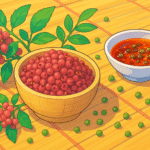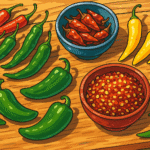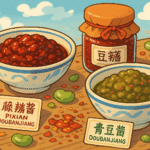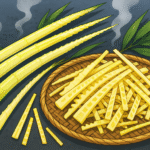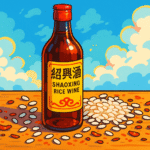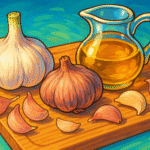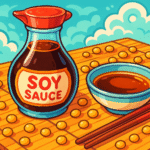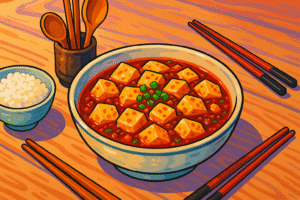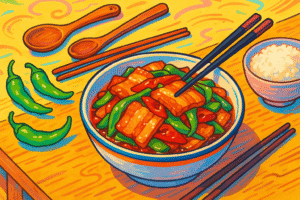Sichuan Cuisine

Sichuan cuisine (“Chuan Cai”) hails from the mountainous, misty province of Sichuan in southwestern China. With its unapologetically bold flavors, Sichuan cuisine balances spice, fragrance, and mouth-tingling sensations – a firm favorite of anyone with a taste for the spicier things in lide.
Some of the most widespread (and celebrated) Chinese dishes worldwide originate from this region. For example, Mapo Tofu and Double-cooked pork are extremely popular dishes in Chinese and Tibetan restaurants – and you may have tried one of these without ever realising it was inspired by cuisine from the Sichuan region.
When it comes to ingredients: expect the taste of dried chilies and the Sichuan peppercorn, delivering the numbing and spicy sensation known as “málà”.
But don’t be fooled into thinking it’s all about the spice! Beyond heat, Sichuan cooking has it all: sweet and sour, smoky and savory. With aromatic herbs and fermented ingredients like doubanjiang (spicy bean paste), each dish — from mapo tofu to kung pao chicken — is a flavor explosion, perfect for any foodie.
The History of Sichuan Cuisine
Sichuan cuisine traces its foundations back over two millennia (yes – you heard that right!)
Ancient natives of the Sichuan region always made use of local garlic, ginger, and fermented sauces. However, the arrival of chili peppers from South America in the 16th century utterly transformed the local foodscape.
Sichuan cuisine also has major cultural significance, with Ming and Qing dynasty culinary texts (dating as far back at the 1400s) mentioning its prowess. The key takeaway from these texts? Recognizing that sichuan chefs could achieve “one dish,[with] many flavors.”
Today, Sichuan cuisine reigns both in local teahouses and on the global stage, influencing chefs worldwide. Because who doesn’t enjoy the marriage of flavor and sensations; from controlled heat to layered flavor.
Key Ingredients in Sichuan Cuisine
Top Dishes in the Region
Top Food Destinations in the Region

Yibin
Yibin’s culinary calling card is Yibin burning noodles (ran mian), wok-fried for smoky depth, then tossed with sesame, chilies, and spring onions. Local teahouses offer snacks laced with pickled vegetables and bamboo shoots, reflecting the city’s river valley terroir.
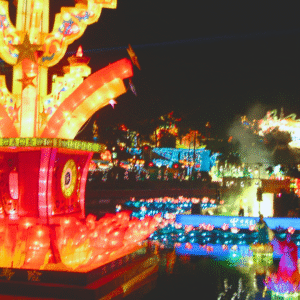
Zigong
Once a major salt capital, Zigong boasts a unique take on hot pot known for extra-robust broths and rare ingredients like duck intestine and fresh eel. The city also delights with hearty, smoky flavors perfected during centuries of salt production.

Leshan
Famed for its giant Buddha, Leshan also claims its own specialties, such as spicy boiled fish (shui zhu yu) and doufunao, a savory tofu pudding steeped in chili oil. Scenic riverside markets buzz with snack vendors and local produce.
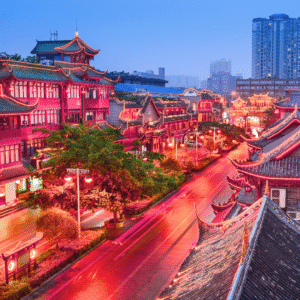
Chengdu
China’s “City of Gastronomy” and the capital of Sichuan province. Chengdu bursts with street food stalls serving dan dan noodles, rabbit head, tea-smoked duck, and bubbling hot pots around every corner. Visit the Jinli Ancient Street or Chunxi Road for classics both traditional and modern.
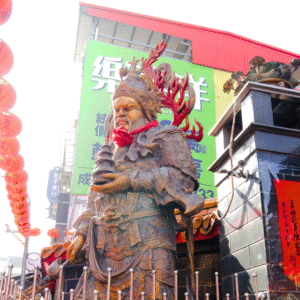
Luzhou
Home to some of China’s most fragrant baijiu (grain spirit), Luzhou is also loved for its unique river fish hot pot, sweet fermented tofu, and chili-smacked street sweets. It’s a must-stop for adventurous eaters and spirit enthusiasts.
Our favorite content showcasing Sichuan Cuisine
Check out some of the content creators showing you the real food of the sichuan region! Here are some of our favorites:
FAQs About Sichuan Cuisine
What is “málà” and why is it so iconic?
Málà refers to the invigorating combination of spicy heat from chili peppers and the mouth-numbing sensation from Sichuan peppercorns. Unique to Sichuan food, it excites the senses, making each bite feel vibrant and memorable. This signature flavor is the reason dishes like hot pot and mapo tofu stand out.
Is all Sichuan food extremely spicy?
Not every Sichuan dish is all fire and brimstone. The cuisine’s reputation for heat is well-deserved, but it also thrives on balance. Many preparations showcase delicate flavors, like steamed fish with pickled chilies, “strange flavor” cold noodles, or savory pumpkin cakes. The variety means there’s something for every palate.
What ingredients set Sichuan cuisine apart?
Signature Sichuan staples include dried red chilies, Sichuan peppercorns, garlic, ginger, scallions, doubanjiang (fermented broad bean and chili paste), pickled vegetables (paocai), and rich, dark soy sauce. Unique methods — dry-frying, smoking, and brine-pickling — also stamp every dish with unmistakable character.
How is Sichuan hot pot different from other Chinese hot pots?
Sichuan hot pot is a communal feast built around a bubbling cauldron of málà-infused broth, loaded with chilies, peppercorns, garlic, and sometimes beef tallow. Diners add meats, vegetables, and noodles to cook tableside, then dip them in garlicky sesame or vinegar sauces. The broth’s intensity and the numbing, spicy sensation make it a sensory experience unlike milder Cantonese or Beijing styles.
Has Sichuan cuisine influenced food outside China?
Absolutely. The appeal of Sichuan flavors has gone global, inspiring restaurants and home cooks worldwide. Dishes like kung pao chicken and mapo tofu have become staples wherever spice-lovers reside. The málà effect shows up in everything from fusion tacos to snack foods, as chefs chase that elusive balance of heat, scent, and tingling sensation.
